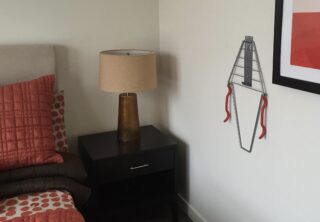
(Photos: Liz Hormann/City of Portland)
Story by Chris Smith, a member of the Portland Planning & Sustainability Commission. He previously wrote about how bicycles and streetcars can co-exist.
After a supportive vote from the Portland Planning & Sustainability Commission (PSC) at their meeting last month, the first full overhaul of Portland’s Bicycle Parking zoning code in two decades is now headed to City Council.
The package is largely similar to the output of a stakeholder committee last year, as refined in the proposed draft (PDF) sent to the PSC, with one big exception: something we’re calling “bike nooks”.
Our current parking code (from last century) allowed bike parking to be located in an apartment or condo, something no other major city allows. Despite efforts to refine this code in 2010, we still saw horror stories like bike racks above beds or couches (see photo).
The proposal for our new code limited in-unit bike parking to 20 percent of all required bike parking in a multi-family building. But the PSC heard from developers — particularly affordable housing developers — who wanted the flexibility to use in-unit parking to keep housing costs lower. We also heard concerns about theft from large bike rooms to which many people have access (even though the new code tightens bike room security standards). We also heard some community members who expressed a preference for storing their bike(s) in their units.
Advertisement
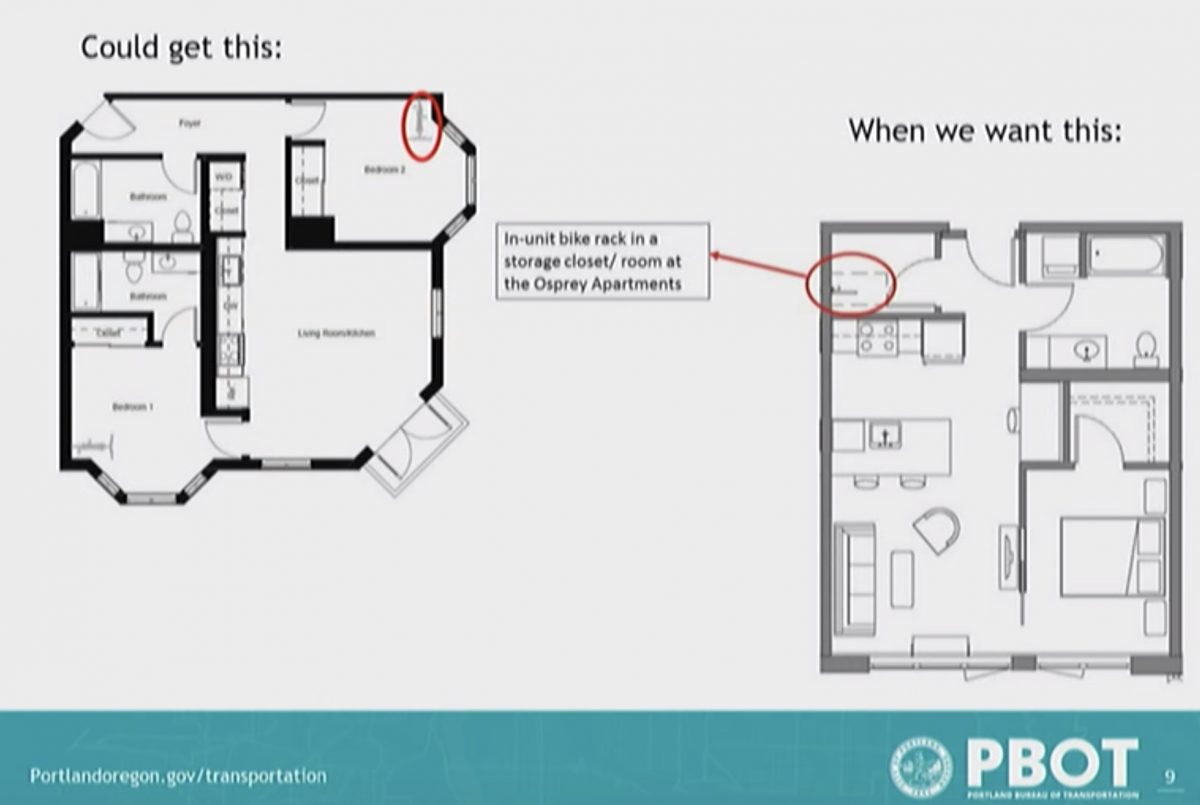
Bike rooms (outside of dwelling units) are still important: the code requires 30 percent of bike spaces to be horizontal (for folks who can’t or don’t want to lift a bike onto a wall rack) and 5 percent of the spaces have to be large enough to accommodate a “bakfiets”-style cargo bike or a bike with a trailers.
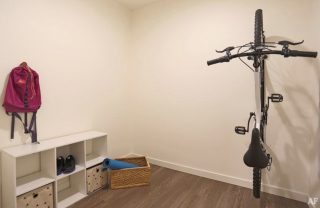
But in response to what we heard, the PSC recommended allowing 50 percent of parking to be allowed in-unit — with a twist. It has to meet new usability standards. Specifically, the in-unit parking must be in “a closet or alcove” (i.e., it can’t be in the living room, bedroom or kitchen) and must be within 15-feet of the front door of the unit. In stipulating this requirement we’ve created a new type of apartment feature: the bike nook.
We have existing examples in Portland, the Osprey apartments in South Waterfront features well-designed bike nooks. We think this is a good compromise: It will allow housing builders more flexibility while also improving the quality of in-unit bike parking.
We’re not exactly sure how bike nooks will be implemented. Will they be the next Portland innovation that will sweep the nation? Or an experiment that doesn’t pay off? What do you think?
The Portland Bureau of Transportation is currently revising their code update draft with the PSC’s recommendations and they expect to bring the final update to City Council this summer. For more details, see the list of PSC amendments to PBOT’s draft proposal here (PDF).
— Chris Smith, @chrissmithus on Twitter
Never miss a story. Sign-up for the daily BP Headlines email.
BikePortland needs your support.


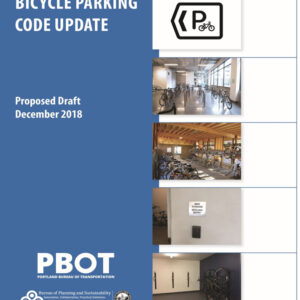

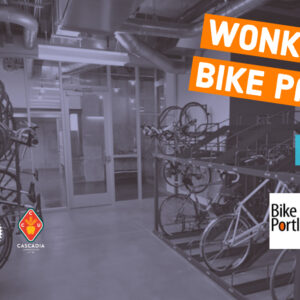
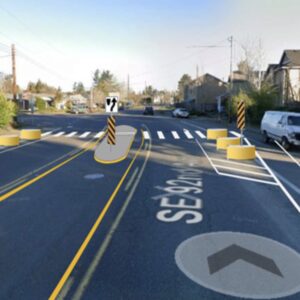
Thanks for reading.
BikePortland has served this community with independent community journalism since 2005. We rely on subscriptions from readers like you to survive. Your financial support is vital in keeping this valuable resource alive and well.
Please subscribe today to strengthen and expand our work.
I live in an 800 sq ft 2-story rented townhome ($700/m) in NC, a/c d/w 1.5 b, 2 br, w/d. I’ve lived in rental accommodation for my entire adult life. I keep 3 bikes near my front door in a portion of my living room I refer to as my “garage”, two bikes on hooks on the wall, and the bike of the week on the floor just as I enter my apartment, along with my tools and workstand. I’d be crazy to park my bike outside. Aside from the threat of theft, there’s the rain and acid fog to deal with – anything steel rusts out here. When I look for an apartment, I prefer ones like “We could get this”, as that of your “When we want this” I’d have to roll my filthy bike clear across my entire apartment to park it in my living room, as that’s the only space I can fix my bike (set up my repair stand and swing the bike around.) I’d rather have my living room in the front, next to the front door – saves a huge amount of my very limited and precious living space.
Comment: “Could get this” has lots of natural light, very nice unit, though two full bathrooms is a little excessive. “When we want this” is a dark forbidding unit, natural light only on one side, like an old-fashioned tenement, very poorly designed. Why would anyone want to live there?
Wow you’re stuck up!
Yup. So what’s your hook? How do you store your 2.3 bikes? How do you keep the mud and chain oil off your carpet?
Yes please! I would love to live in an apartment with a bike nook. I don’t think I will ever trust a shared bike room for round-the-clock storage (in America). Which is a shame because that’s obviously a more efficient use of space.
Nooks seem like a decent compromise. Regardless of security standards, I’m simply not storing my babies in one of those rooms.
I hope that common sense prevails and that this isn’t a mandate for idle parking spaces inside the home. This is no better than outside in the parking lot. This costs several hundred dollars per year at current rates for new construction. Let the space be flexible for non-bike uses.
My concern about that 50% maximum is that it could be a perverse disincentive to provide additional in-unit parking. Seems kind of silly that by providing four in-unit spaces for a 2BR apartment means you also have to put four spaces somewhere else in the building. To me, it seems fairer to require no more than the number of sleeping areas (1 per studio/1BR, 2 per 2BR, etc.) in the unit.
There is no mandate that the nooks can only be used for bikes. There does have to be a rack on the wall, but nobody is going to be checking whether you have a bike there, or a kayak, or your dirty laundry.
There is an amount of mandated parking for every new building (1.5 spaces per unit for most of the City). Half of that MUST be in a bike room (except for very small developments). The other half MAY be in units, but could also be in bike rooms.
Note the plural rooms. Best practice for security will probably be to have multiple rooms with access limited to a subset of users rather than having every resident have access to every bike room (or one big bike room).
I always kept my bike in the living room of any apartment (and some houses) I’ve lived in, so I’m all for having a workable in-unit place to store a bike. I wouldn’t use a separate facility.
But I hate rules such as the ones being proposed–the “in a closet or alcove” and “within 15′ of the front door”. It’s a fine goal, and sometimes, that may work out great, but other times not. Requiring the alcove and distance starts turning unit design into a puzzle-solving exercise. The intentions are fine, but the reality is that rules like that, when piled on top of other rules for adaptable units and other code requirements, can mean achieving compliance with the bike storage rule only at the expense of other things that may be much more appreciated by a tenant, including ones with bikes.
As an example, in the “what we want” floor plan, I’d much prefer that unit if the closet the bike were in were eliminated completely, and the kitchen moved back there, and all the space of the closet put in the living room, creating a much larger living room that would have some big open wall space to put a bike against.
I realize others may prefer the unit as drawn. But I don’t like that this new rule would make the plan I prefer illegal. That’s especially so when the bike parking in the more open unit I described–straight ahead against an open wall, instead of having to turn 90 degrees and open a closet door and lift my bike on and off a hook every time I used it–would work much better for me that what the new code mandates.
This city has gotten so bougie.
Absent some kind of standards for the in-unit bike storage we were seeing useless implementations, like a bike hook over a bed. The ‘alcove’ and 15 feet standards were intended to make sure we actually got useful storage space. Developers can request an adjustment if they believe they have a better way to achieve the purpose.
It’s a reasonable approach. It’s an ongoing problem in Portland, though. The rules that prevent bad design make it harder to do good design. Theoretically, the adjustment process is an alternative. In reality, many owners are not going to want to go through an adjustment to make better bike storage when they can get by with a worse one that meets the standard. But then again I’d rather have an imperfect rule that does allow the in-unit storage. The scary thing is people will still figure out how to do horrible storage that meets the new rule.
Thanks for all your work on this, Chris Smith!
So let me see if I understand correctly.
People are up in arms because of the quality of their in-home bike parking when we have thousands of people sleeping outside in all weather every night?
Yeah, okay. Just checking.
..::throws hands in the air::..